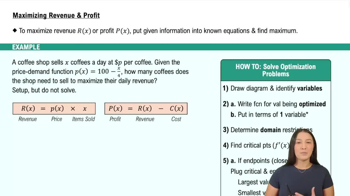Table of contents
- 0. Functions7h 52m
- Introduction to Functions16m
- Piecewise Functions10m
- Properties of Functions9m
- Common Functions1h 8m
- Transformations5m
- Combining Functions27m
- Exponent rules32m
- Exponential Functions28m
- Logarithmic Functions24m
- Properties of Logarithms34m
- Exponential & Logarithmic Equations35m
- Introduction to Trigonometric Functions38m
- Graphs of Trigonometric Functions44m
- Trigonometric Identities47m
- Inverse Trigonometric Functions48m
- 1. Limits and Continuity2h 2m
- 2. Intro to Derivatives1h 33m
- 3. Techniques of Differentiation3h 18m
- 4. Applications of Derivatives2h 38m
- 5. Graphical Applications of Derivatives6h 2m
- 6. Derivatives of Inverse, Exponential, & Logarithmic Functions2h 37m
- 7. Antiderivatives & Indefinite Integrals1h 26m
- 8. Definite Integrals4h 44m
- 9. Graphical Applications of Integrals2h 27m
- 10. Physics Applications of Integrals 2h 22m
5. Graphical Applications of Derivatives
Applied Optimization
Problem 4.R.39
Textbook Question
Optimization A right triangle has legs of length h and r and a hypotenuse of length 4 (see figure). It is revolved about the leg of length h to sweep out a right circular cone. What values of h and r maximize the volume of the cone? (Volume of a cone = (1/3) πr²h.) <IMAGE>
 Verified step by step guidance
Verified step by step guidance1
First, express the relationship between the sides of the right triangle using the Pythagorean theorem: h² + r² = 4².
Solve the Pythagorean equation for one of the variables, say r, in terms of h: r = sqrt(16 - h²).
Substitute the expression for r into the volume formula of the cone: V = (1/3)π(sqrt(16 - h²))²h.
Simplify the volume expression: V = (1/3)π(16 - h²)h.
To find the maximum volume, take the derivative of V with respect to h, set it equal to zero, and solve for h. Then, use this value to find r using the expression from step 2.
 Verified video answer for a similar problem:
Verified video answer for a similar problem:This video solution was recommended by our tutors as helpful for the problem above
Video duration:
5mPlay a video:
Was this helpful?
Key Concepts
Here are the essential concepts you must grasp in order to answer the question correctly.
Volume of a Cone
The volume of a cone is calculated using the formula V = (1/3)πr²h, where r is the radius of the base and h is the height. This formula derives from the geometric properties of cones and is essential for determining the maximum volume in optimization problems. Understanding how to manipulate this formula is crucial for solving the given problem.
Recommended video:

Example 5: Packaging Design
Optimization
Optimization in calculus involves finding the maximum or minimum values of a function. In this context, we need to maximize the volume of the cone by adjusting the dimensions h and r. Techniques such as taking derivatives and applying critical point analysis are fundamental to solving optimization problems effectively.
Recommended video:

Intro to Applied Optimization: Maximizing Area
Right Triangle Relationships
In this problem, the right triangle formed by the legs h and r and the hypotenuse (length 4) is governed by the Pythagorean theorem, which states that a² + b² = c². This relationship allows us to express one variable in terms of the other, facilitating the optimization process by reducing the number of variables involved.
Recommended video:

Estimating the Area Under a Curve with Right Endpoints & Midpoint

 1:13m
1:13mWatch next
Master Intro to Applied Optimization: Maximizing Area with a bite sized video explanation from Callie
Start learningRelated Videos
Related Practice







